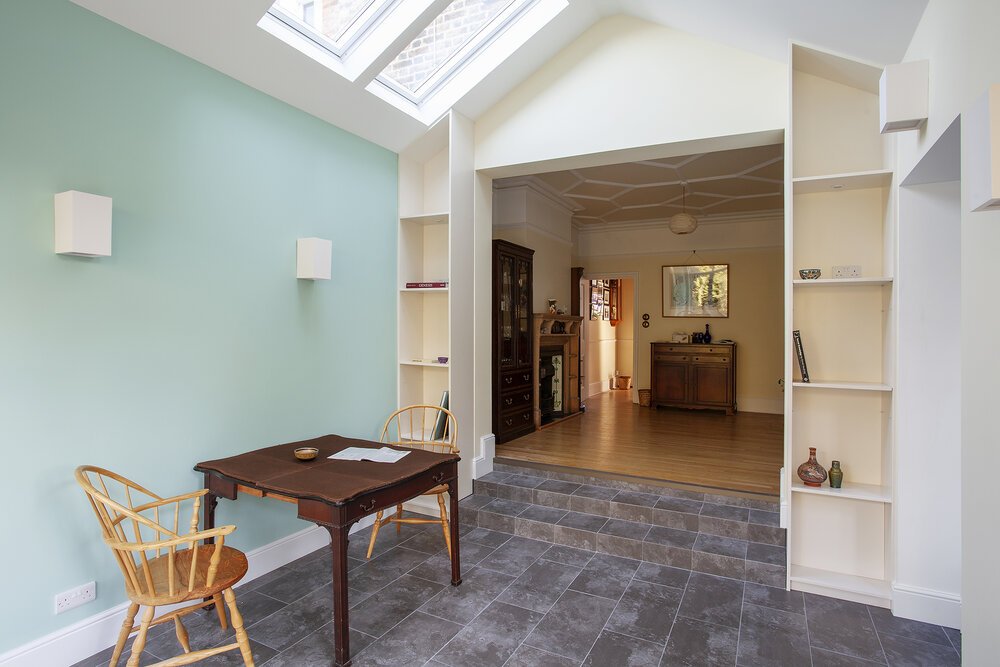In the realm of home design, natural illumination is a powerful tool that can transform any space, creating an inviting atmosphere and enhancing the overall aesthetic. If you're planning a pitched roof extension, incorporating skylights is a surefire way to flood your space with beautiful, natural light.
Skylights have long been favored by architects and homeowners alike for their ability to brighten up dark corners and create a seamless connection between indoors and outdoors. Whether you're aiming to create a cozy reading nook or a light-filled dining area, skylights offer a versatile solution to maximize daylight and create a sense of openness.
With the right placement and design, skylights can not only illuminate your space but also provide additional ventilation and stunning views of the sky above. From traditional to modern, the options are endless when it comes to skylight styles and finishes, allowing you to find the perfect match for your pitched roof extension.
Benefits of natural illumination in home design
When it comes to home design, natural illumination has a multitude of benefits that go beyond aesthetics. The use of skylights in a pitched roof extension can significantly enhance the overall atmosphere and livability of the space. By harnessing natural light, you can create a welcoming and uplifting environment that positively impacts your mood and well-being. Natural light has been proven to improve productivity, increase focus, and even regulate our sleep-wake cycles. Additionally, by relying more on natural light, you can reduce your energy consumption and lower your electricity bills. Skylights are an eco-friendly solution that allows you to enjoy the beauty of nature while being conscious of your environmental impact.
Understanding different types of skylights for pitched roofs
When it comes to skylights for pitched roofs, there are several options to choose from. The most common types include fixed skylights, vented skylights, and tubular skylights. Fixed skylights are stationary and do not open, making them ideal for areas where ventilation is not a priority. Vented skylights, on the other hand, can be opened and closed to allow for air circulation and improved ventilation. These are especially useful in areas such as kitchens and bathrooms where moisture control is important. Lastly, tubular skylights are a compact option that uses reflective tubes to capture and distribute natural light throughout the space. They are particularly useful in rooms with limited ceiling space or where traditional skylights are not feasible. Each type of skylight has its own unique characteristics and benefits, so it's important to consider your specific needs and preferences when making a decision.
Factors to consider when choosing skylights for your pitched roof extension
Choosing the right skylights for your pitched roof extension requires careful consideration of various factors. One of the key considerations is the size and placement of the skylights. The size of the skylights should be proportional to the size of the room and the pitch of the roof. Oversized skylights may result in excessive heat gain or loss, while undersized ones may not provide sufficient light. The placement of the skylights is also crucial in maximizing natural illumination. Consider the orientation of your roof and the path of the sun throughout the day to determine the optimal placement for the skylights. Additionally, it's important to think about the design and aesthetics of the skylights. Choose a style and finish that complements the overall design of your pitched roof extension and enhances its visual appeal.
Installation process and considerations for skylights in pitched roof extensions
Installing skylights in a pitched roof extension requires careful planning and professional expertise. The first step is to consult with a qualified contractor or architect who specializes in skylight installations. It's important to ensure that the installation process is done correctly to prevent any leaks or damage to your roof. Proper insulation and flashing are essential to maintain the integrity of the roof and ensure the skylights are weatherproof. Additionally, consider the type of glazing for the skylights. Options include single-pane, double-pane, and even triple-pane glazing, each offering different levels of insulation and energy efficiency. The installation process may vary depending on the type of skylights chosen, so it's crucial to follow the manufacturer's instructions and consult with professionals throughout the process.
Tips for maximizing natural illumination with skylights in your pitched roof extension
To make the most of natural illumination in your pitched roof extension, there are a few tips and tricks to keep in mind. First and foremost, consider the placement and size of the skylights. Optimal placement allows for the maximum amount of natural light to enter the space throughout the day. Additionally, consider using skylight covers or blinds to control the amount of light and heat entering the room. This allows you to adjust the lighting levels based on your preferences and the time of day. Another tip is to strategically place mirrors or reflective surfaces near the skylights to amplify the natural light and create a brighter and more spacious feel. Finally, don't forget to incorporate other elements of interior design that can enhance natural illumination, such as light-colored walls, reflective flooring, and strategically placed furniture to maximize the light's reach.
Maintenance and care for skylights in pitched roof extensions
Proper maintenance and care for your skylights are essential to ensure their longevity and performance. Regular cleaning is important to prevent dirt and debris from obstructing the light and compromising the clarity of the skylights. Use a non-abrasive cleaner and a soft cloth to gently remove any dirt or residue. Additionally, inspect the skylights for any signs of damage, such as cracks or leaks, and address them promptly to prevent further issues. Keep an eye on the seals and flashing around the skylights to ensure they remain watertight and weatherproof. It's also a good idea to have your skylights professionally inspected and serviced on a regular basis to identify any potential issues early on and prevent costly repairs down the line.
Case studies of successful pitched roof extensions with skylights
To gain inspiration and see the transformative power of skylights in pitched roof extensions, let's take a look at a few case studies. One example is a cozy attic conversion that utilized skylights to turn a dark and cramped space into a bright and airy bedroom. By strategically placing skylights along the sloping roof, the room is now flooded with natural light, creating a serene and inviting atmosphere. Another case study involves a kitchen extension that features a large, glass-roofed skylight. This design element not only floods the kitchen with daylight but also provides a stunning view of the sky above, creating a unique and captivating focal point. These case studies demonstrate the versatility and impact of skylights in transforming pitched roof extensions into beautifully illuminated spaces.
Cost considerations for skylights in pitched roof extensions
When considering skylights for your pitched roof extension, it's important to factor in the cost implications. The cost of skylights can vary depending on factors such as size, type, and design. Fixed skylights tend to be more affordable compared to vented or tubular skylights. Additionally, the cost of installation should be taken into account, including any necessary modifications to the roof structure and the expertise required for a proper installation. It's worth noting that while skylights may require an upfront investment, they can provide long-term energy savings and increase the value of your home. Consider your budget and priorities when making a decision, and consult with professionals to get accurate cost estimates for your specific project.
Conclusion: Transforming your pitched roof extension with skylights
Skylights have the power to transform a pitched roof extension into a bright and airy haven, maximizing natural illumination and creating a seamless connection between indoors and outdoors. By harnessing the beauty of natural light, you can enhance the overall atmosphere and livability of your space while reducing your energy consumption. Understanding the different types of skylights, considering the factors that influence their selection, and following proper installation and maintenance practices are key to maximizing their benefits. Whether you're looking to create a tranquil bedroom or a vibrant living area, skylights offer a versatile solution that can elevate the aesthetics and functionality of your pitched roof extension. So, let the light in and embark on a journey of transforming your space into a beautifully illuminated sanctuary.
























